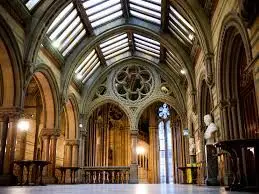Central Library and the Town Hall Extension Manchester
Over 200 views on venues4hire.org

Manchester Town Hall - Manchester Town Hall
To make a booking or enquire about hiring this venue please use the contact details below - Please mention Venues for Hire
+44 161 234 5000
Bookings Administrator
Use contact form below
Central Library and the Town Hall Extension Manchester description
Community Hall
Medium (1-150)
Manchester Town Hall (1868-77) in Albert Square is one of the most iconic landmarks in the city. Regarded as one of the finest examples of Neo-Gothic architecture in the United Kingdom. It is one of the most important Grade One listed buildings in England.
The town hall was built because the neo-classical town hall in King Street had become too small to house the expanding business of the corporation. A competition was held and won by Alfred Waterhouse (1830-1905), mainly for his ingenious planning. The site was an irregular triangle on which had to be fitted a large hall, a suite of reception rooms and living quarters for the Lord Mayor, as well as offices for all the corporation departments and a chamber for council meetings. Waterhouse successfully combined the ceremonial and workaday requirements.
The Town Hall was designed in the thirteenth century Gothic style but it was, in Waterhouse's words, a building "essentially of the nineteenth century." It incorporated innovations such as a warm air heating system. The structure comprises fourteen million bricks encased in Spinkwell stone.
The exterior of the Town Hall bears some notable sculptures. Over the main door is a statue of the Roman General Agricola, who founded Mamucium in 79 AD. Above him are Henry III and Elizabeth I, while at the apex of the main door gable is a statue of St. George.
Centrally placed is the imposing 280 foot high clock tower. The clock mechanism was made by Gillet and Bland, and was started on New Year's Day 1879. The inscription on the three clock faces which are visible from Albert Square reads "Teach us to number our Days." There are 24 bells in the tower; the Great Hour Bell weighs 8 ton and 2 cwt and is called Great Abel, named after Abel Heywood, the Mayor at the time of the official opening. He laid the pinnacle stone of the spire on 4 December 1875. The formal opening ceremony took place on 13 September 1877.
The cost of the Town Hall was around £1 million. The main Albert Square entrance has an archway 7 feet deep - the thickness of the wall supporting the main tower. In the glass mosaic roof of the entrance hall is an oak trapdoor through which the tower's bells can be lowered to street level. On one side of the entrance hall is Chantrey's statue of the famous chemist and philosopher, John Dalton and on the other, a statue of the great physicist, James Joule.
The Town Hall and the nearby Central Library and Town Hall Extension are known collectively as the Town Hall Complex.
The town hall was built because the neo-classical town hall in King Street had become too small to house the expanding business of the corporation. A competition was held and won by Alfred Waterhouse (1830-1905), mainly for his ingenious planning. The site was an irregular triangle on which had to be fitted a large hall, a suite of reception rooms and living quarters for the Lord Mayor, as well as offices for all the corporation departments and a chamber for council meetings. Waterhouse successfully combined the ceremonial and workaday requirements.
The Town Hall was designed in the thirteenth century Gothic style but it was, in Waterhouse's words, a building "essentially of the nineteenth century." It incorporated innovations such as a warm air heating system. The structure comprises fourteen million bricks encased in Spinkwell stone.
The exterior of the Town Hall bears some notable sculptures. Over the main door is a statue of the Roman General Agricola, who founded Mamucium in 79 AD. Above him are Henry III and Elizabeth I, while at the apex of the main door gable is a statue of St. George.
Centrally placed is the imposing 280 foot high clock tower. The clock mechanism was made by Gillet and Bland, and was started on New Year's Day 1879. The inscription on the three clock faces which are visible from Albert Square reads "Teach us to number our Days." There are 24 bells in the tower; the Great Hour Bell weighs 8 ton and 2 cwt and is called Great Abel, named after Abel Heywood, the Mayor at the time of the official opening. He laid the pinnacle stone of the spire on 4 December 1875. The formal opening ceremony took place on 13 September 1877.
The cost of the Town Hall was around £1 million. The main Albert Square entrance has an archway 7 feet deep - the thickness of the wall supporting the main tower. In the glass mosaic roof of the entrance hall is an oak trapdoor through which the tower's bells can be lowered to street level. On one side of the entrance hall is Chantrey's statue of the famous chemist and philosopher, John Dalton and on the other, a statue of the great physicist, James Joule.
The Town Hall and the nearby Central Library and Town Hall Extension are known collectively as the Town Hall Complex.
Venue suitability
This venue is suitable for the following uses:
Venue facilities
Other venue facilities
We don't currently hold any detailed information about the rooms at this Venue.
If this is your Venue or Hall please use the Adopt link on the right to add more detailed information about this Venue.
If you wish to hire this Venue or Hall please use the contact details on the overview tab.
Please encourage every Venue to take a few minutes to 'Adopt' their listing and add unique content and photos.
